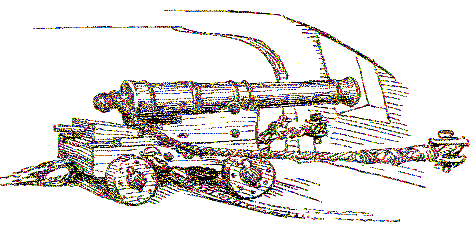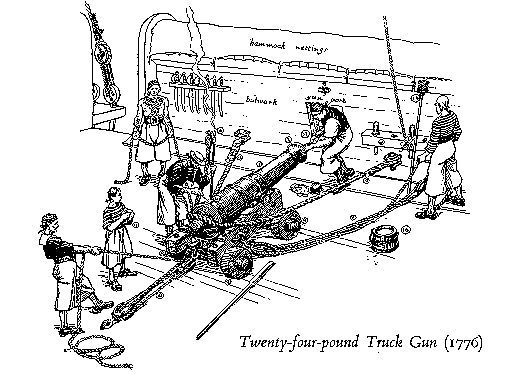
(See Figure Figure 15, Cannons)
The focus of this narrative will be the Naval artillery during the golden age of piracy, the eighteenth century. However, to get a better understanding of naval artillery and its employment I will briefly discuss its origins.
The 16th Century, Birth of Naval Artillery
It is certain that missile throwing devices have been apart of naval vessels since recorded history. For instance, early Roman ships mounted small catapults that launched flaming pots of oil and stones at enemy vessels. However the cannon did not truly establish a foot hold aboard European ships until the Sixteenth Century, 200 years after its introduction in the armies on the continent. The main reason was the portability of cannons.
At around the time of Columbus' voyage to the New World, naval artillery consisted of the same heavy artillery used on land. The wheels had been removed and the gun had been mounted to flimsy frames. The guns were lashed down to the upper decks and there was no way to sight them, other than by trial and error.
By the end of the 16th Century, Naval artillery had been born. The guns were now mounted on small two or four wheel carriages, making them portable. The muzzle loading barrel was attached to the carriages using a trunnion and elevation was adjusted by driving in and out the quoin supporting the breech. Swivel guns were mounted on the poop deck and along the railing to repel boarders and the main guns had been strategically placed to provide all around security for the ship. Chase guns were placed at the bow and stern of the ship and on the larger ships as many as fifty guns may have been carried. The majority of the guns were placed on the side of a ship.
The main tactic for attacking another ship was to show the side of your ship to the foe and deliver a broadside attack, or fire all of your guns into their ship. The key to success was to do so with out allowing your enemy to get in position to do the same to you. England had managed to defeat the Spanish Armada in 1588, partly due to their more maneuverable ships as well as the longer range of the English guns over those carried on the Spanish Galleons.
17th Century
The main changes in the 17th century involved sizes and numbers. European ships were now carrying as many as 100 guns on three separate decks. 42 pounder guns were often the standard gun on the bottom decks. Special shots or artillery rounds were being developed especially for naval use. Barshot, chain shot, were rounds designed to destroy rigging and sails. Bundle shot, canister, grape shot were used against personnel. Cluster rounds and Sangrenel rounded out the variety of shots fired from the Cannon.(See: Ammuniion)
The 18th Century
Ships of War had improved dramatically by the opening of the 18th Century, In fact, the Golden Age of Piracy was probably the Golden Age of Sail as well. Cast Iron muzzle loaders ranging from the small 6 pounders to the large 32 pounders were the general rule. Elevation was adjusted by a modified quoin under the breech and the general science of trajectory was better understood. Fixed loads of powder were calculated for the guns improving accuracy and the guns were secured to the sides of the ships by heavy breech ropes passed through or around the casabels, limiting recoil and aiding in the reloading of the guns. Side tackles were also added as well as small ramps behind the guns to aid in pulling them back into firing position.

The Naval Artillery had unheard of range of about 2,000 yards (meters) by this time. Of course most engagements were fought at under 1,000 yards and sometimes within pistol shot (25 to 50 yards) The only innovation in artillery rounds for this time period was the art of heating solid iron shot to a red hot condition before firing the round. It was a tricky affair, because the heat of the hot iron could cause a cook off, that is an early discharge of the cannon, thus killing your own cannoneers. The usual method for firing red hot iron was to swab the barrel with water then dry the inside, add the powder, followed by a plug of wood and then the loose fitting hot iron. The purpose of using the hot iron was to set the other ship on fire.
The art of explosive shells also came of age. An explosive cannon ball fitted with a timed fuse would be fired from the gun. If the timing was done properly, the shell would explode when it reached the other ship. Some of the cannons began using a flintlock mechanism for firing instead of the flaming torch that is used in so many movies. The torch could be used but the flintlock was more reliable and much safer. The mechanism worked by pulling a lanyard instead of a trigger.
Why were guns called 6 pounder and 24 pounder guns?
Pounder refers to the size of a gun. A six pounder fired a solid shot of lead which weighed approximately 6 pounds. A 32 pounder fired a ball of lead that weighed approximately 32 pounds. This says little about the approximate weight of the cast iron gun.
For Instance: 6 lbs
| Type | Bore size | Gun weight | Shot weight | Powder weight |
|---|---|---|---|---|
| 2 pounder | 2.5 in | 600 lbs | 2 lbs | 3 1/2 lbs |
| 6 pounder | 3 | 1,000-1,500 lbs | 6 lbs | |
| 24 pounder | 4.5 in | 3,000-4,000 lbs | 24 lbs | 14 lbs |
| 32 pounder | 5 in | 4,000-5,000 lbs | 32 lbs | 18 lbs |
Besides beign identified by the size of the solid shot, artillery pieces also were known by names. This adds to some confusion when reading about artillery at the time. Below is a list od identified artillery pieces and the relative size and caliber of the ordinance.
Ship cannon range
A table of muzzle loading artillery as described in:
On the Spanish Main, or, Some English forays on the Isthmus of Darien,
John Masefield: 1906
| Type of gun | Bore (inches) | Gun Weight (pounds) | Solid shot weight | Powder weight | Point Blank Range (paces) | Range at max elevation | Length in feet |
|---|---|---|---|---|---|---|---|
| Cannon Royal or Double Cannon | 8½ | 8000 | 66 | 30 | 800 | 1930 | 12 |
| Cannon or Whole Cannon | 8 | 6000 | 60 | 27 | 770 | 2000 | 11 |
| Cannon Serpentine | 7 | 5500 | 53½ | 25 | 200 | 2000 | 10 |
| Bastard Cannon | 7 | 4500 | 41½ | 20 | 180 | 1800 | 10 |
| Demi-Cannon | 6½-7 | 4000 | 33½ | 18 | 170 | 1700 | 10 |
| Cannon Petro or Cannon Perier | 6 | 4000 | 24½ | 14 | 160 | 1600 | 4 |
| Culverin | 5-5½ | 4500 | 17½ | 12 | 200 | 2500 | 13 |
| Basilisk | 5 | 4000 | 15 | 10 | 230 | 3000 | 4 |
| Demi-Culverin | 4 | 3400 | 9½ | 8 | 200 | 2500 | 11 |
| Bastard Culverin | 4 | 3000 | 7 | 5¾ | 170 | 1700 | 11 |
| Saker | 3½ | 1400 | 5½ | 5½ | 170 | 1700 | 9 or 10 |
| Minion | 3½ | 1000 | 4 | 4 | 170 | 1700 | 8 |
| Falcon | 2½ | 660 | 3 | 3 | 150 | 1500 | 7 |
| Falconet | 2 | 500 | 1½ | 1¼ | 150 | 1500 | 6½ |
| Serpentine | 1½ | 400 | ¾ | ¾ | 140 | 1400 | 4½ |
| Rabinet | 1 | 300 | ½ | ½ | 120 | 1000 | 2½ |
Probably most crucial in the table above is the weight of the gun carriage compared to the weight of the fired projectile. A small sloop could have great difficulty trying to carry several (if any) 24 pounders simply due to the weight of the gun (2 tons) and the recoil of the carriage. Remember with a sloop or some other small sailing vessels the guns are mounted on the working or top deck which makes the sloop un wieldy unless ballast is added. Thus, if you put a heavy gun on the top deck you may actually need to increase ballast in the hold just to keep the sloop steady in the water. Thus the size of the gun has to proportional to the vessel carrying them or the ship becomes less seaworthy. To ,make matters worse, a really big gun on smaller sailing craft could literally knock the tar out of the ship. That is, shake the ship so badly that the oakum would be jarred loose between the side boards causing the ship to spring leaks.
Another aspect to look at was the intention of the pirates. They came to rob and not sink. A several small guns over one or two big guns would favor the pirate with this goal in mind. This is because bigger guns could cause more damage to the ship but required more men to operate and had a slower turn-around time during reloading. Smaller guns required a smaller crew for operation and less turn around time during salvos. This meant the pirates were able to create a continuous raking of the deck, rigging and ports, causing massive damage to personnel with two or three small guns rather than a slower rate of fire with one big gun.

The only author and editor of all pages on the site. Most of what I write about is based on years of book reading on the topic. My first web page was published back in 1994.